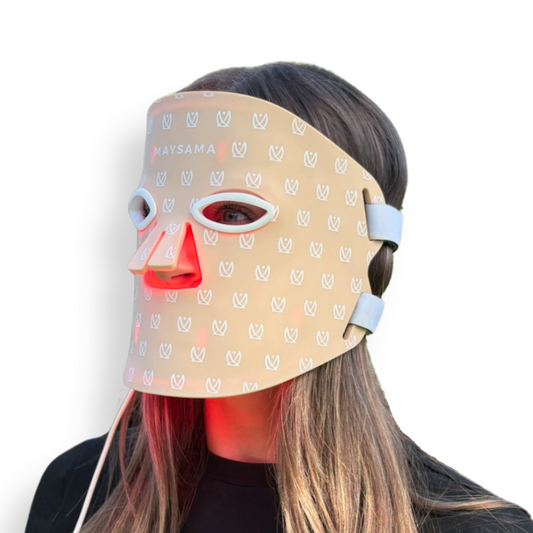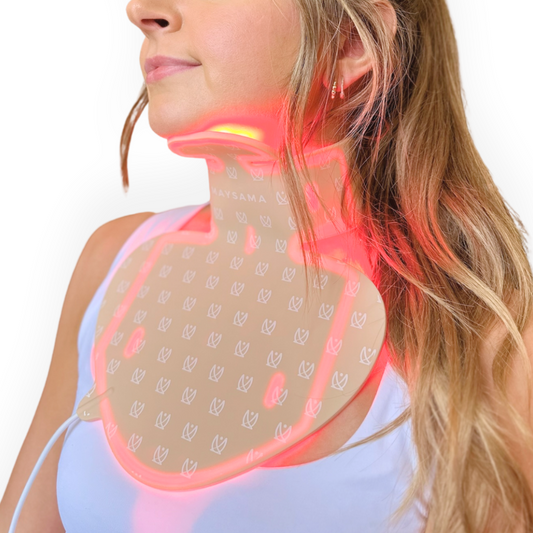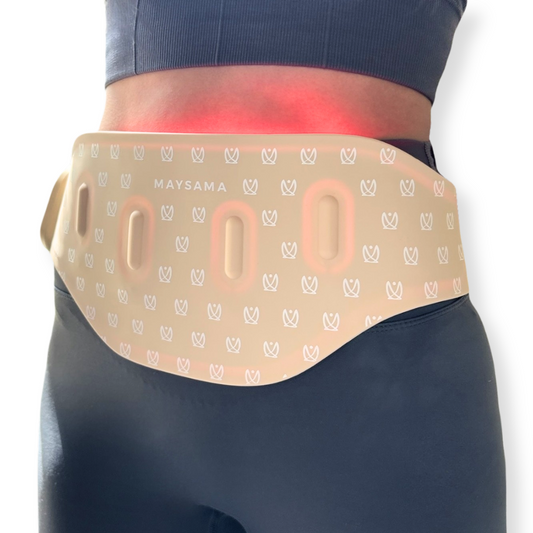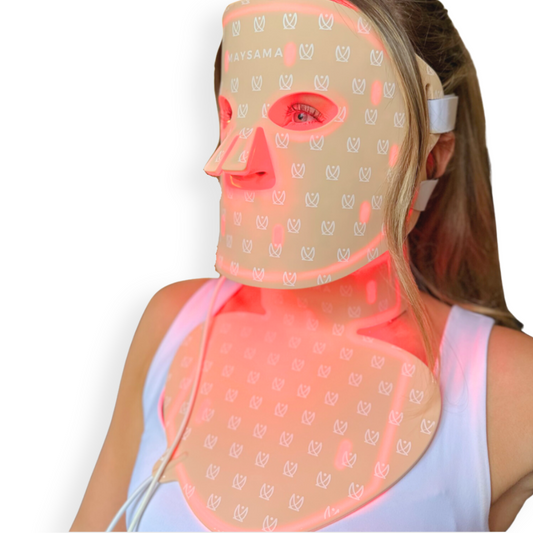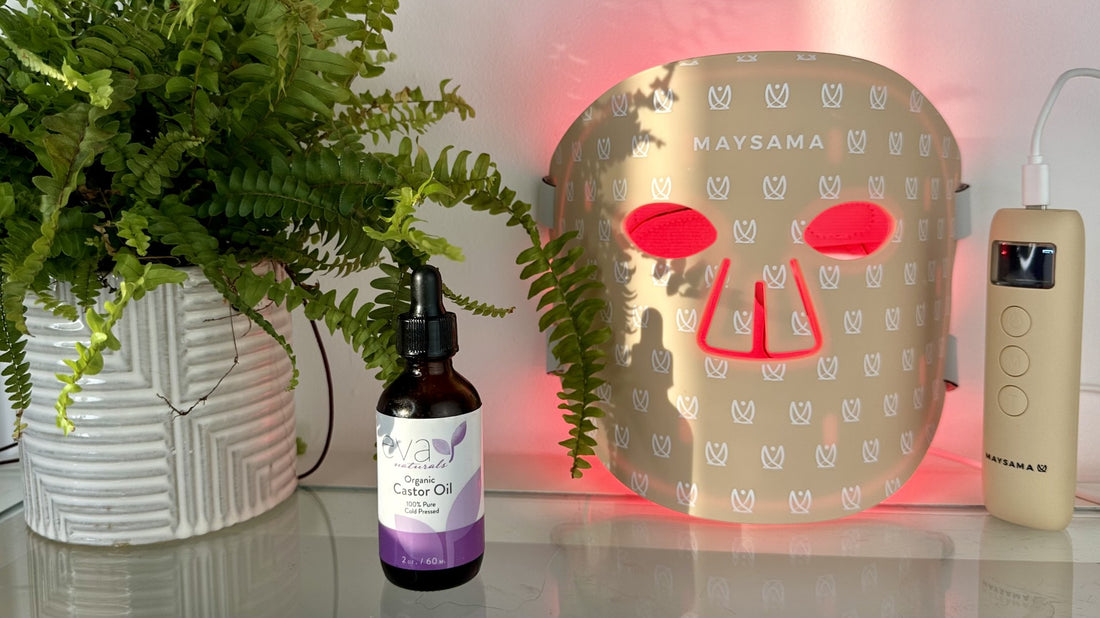
Castor Oil and Red Light Therapy – The New Combo?
Share

Combining castor oil and red light therapy is the latest hack doing its round on social media, with influencers reporting that red light therapy intensifies the beneficial effects of castor oil.
Castor oil has been used for centuries as an elixir for many aliments from alleviating constipation, to detoxifying the liver and improving skin quality. Most of the reported benefits are anecdotal with little or no scientific evidence behind them, but who wouldn’t trust their grandma’s advice?

Castor oil is rich in ricinoleic acid, a monounsaturated fatty acid, known for its moisturising properties, making it a popular choice in skin care. Additionally, castor oil has wound healing properties as it can help reduce inflammation. YouTuber Cojimaru tells us that a year of Red Light Therapy (with Castor oil face pack) cured all her acne, although certified dermatologist Dr Dray advises, whilst castor oil is anti-inflammatory and antimicrobial, which may support in acne clearing, she would recommend alternative treatments.

Other influencers, including HighHeelBeauty and MrsRogersHood use castor oil packs on their abdomen with their red light treatments for liver detoxification. And Instagrammer @AshleyMcNallyNutrition who uses this combo as part of her weekly routine states
‘Castor oil helps improve digestion, lower inflammation, support hormonal balance and improve circulation as well as immunity and gut health, whilst red light therapy stimulates mitochondrial function (aka energy), reduces inflammation, boosts new cell growth, stimulates collagen production and enhances skin rejuvenation’

Bloggers Gracie Smith and Craig Smith report on their hair growth journey with castor oil and red light therapy. Citing they work together to nourish, stimulate and regenerate scalp and hair follicles, Gracie declares it her secret weapon, whilst Craig was blown away by the results.

Meanwhile, at the Haute Healing Oasis in Stamford Connecticut, clients are encouraged to embrace the ‘synergy’ of castor oil and infrared sauna to reap the wide ranging benefits of detoxification, reduced inflammation, stress relief, improved circulation, fading scars and pain relief.

There is no shortage of support for this dynamic duo, but does it really work? Well, this may depend on what your goals are. Combining LED light therapy with the topical application of castor oil will likely increase the absorption of castor oil into the skin, increasing the efficacy of this moisturizing ingredient and any possible deep-seated benefits it has for detoxification.
When it comes to complementing the effects of red light therapy for skin rejuvenation though, are we putting the cart before the horse? The general consensus amongst red light therapy users, as well as the general advice offered by red light device manufacturers, has been that oils can reduce light penetration, so surely applying castor oil to your face before your red light treatment would reduce the anti-aging benefit? I wanted to put this one to bed once and for all, so I have gone down a rabbit hole to see if there is any basis for using, or not using, castor oil (or any facial oils), with your red light therapy.

There are over 7000 published papers in relation to various red light therapy applications and yet my search for studies around emollients or oils with photobiomodulation only threw up a handful of studies. These studies support the use of therapeutic oils like calendula and oregano with red light therapy for treating diabetic foot ulcers. Can we draw any parallels from this with the application of oils for skin rejuvenation? I don’t think so. The rational for combining the two therapies relates simply to red light therapy enhancing the absorption of the oil, not the oil enhancing the effects of red light therapy.

A broader search on the internet around emollients and light therapy did however point me to several studies in relation to phototherapy, not with red or near infrared light but with UV light, used in conjunction with emollients to treat chronic skin conditions. And this, I believe, is where the information around emollients hindering light penetration stems from.
Phototherapy with UV light is a therapeutic modality employed successfully to treat many skin diseases. Chronic skin conditions are frequently pre-treated with emollients to keep the skin moist and support healing. As a conjunct therapy, the compatibility of emollients and UV phototherapy is important to ensure that emollients don’t negatively impact UV light penetration and reduce the efficacy of treatment. This challenge has got the attention of researchers who have tested various emollients with UV phototherapy, to uncover the most suitable emollients for pre-irradiation application in skin diseases.

The outcome of one study, which looked at the blocking or enhancing properties of some basic emollients in UVA penetration, shows that liquid-based topical agents appear to be more effective in enhancing UV penetration than thick petrolatum-based compounds. The study demonstrated that certain emollients, including mineral oil, Vaseline oil, and glycerol enhance UV light penetration. Interestingly these emollients have a refractive index closest to that of normal stratum corneum (skin). Conversely, other emollients, like petrolatum, coconut oil, and sunflower oil have a UV-blocking effect. These emollients were reported to have a refractive index farthest from that of normal stratum corneum.
The refractive index of skin is taken as 1.5, although it can vary depending on the moisture content of the skin, age, gender and melanin content of the skin, as a recent study on the optical properties of skin shows, which involved 198 Japanese volunteers. Interestingly, the emollients which were seen to enhance light penetration (mineral oil, vaseline oil, and glycerol) have a refractive index of 1.47, relatively close to skin. Whereas the emollients which hindered light penetration, including petrolatum and shea butter, are lower at 1.46 and coconut oil is as low as 1.43.

As emollients which have a refractive index close to skin increase UV light penetration, then it may follow that they also increase the penetration of red and near infrared light. If this is the case, then facial oils formulated with oils like castor oil, grape seed oil, olive oil or avocado oil, which all have a refractive index of 1.47 similar to skin, may well aid light penetration for use with red light therapy. So, I am excited at the prospect that facial oils can probably be added to the list of skincare which we can use as a pre-treatment to red light therapy to enhance its effects for pro-aging.
Maysama’s formulates skincare for use with red light therapy treatments and offers LED beauty devices for targeted skin rejuvenation treatments. Our hero skincare ingredient, Aspalathin-enriched Green Rooibos Extract, has been proven to amplify and accelerate the effects of red light therapy treatments for pro-aging benefits. Check out our Complete LED skincare range for use with your Red Light Therapy treatments.

Maysama’s Green Rooibos Bioferm Facial Oil is infused with our signature green rooibos extract and fortified with fermented Dragon’s Blood Oil and our proprietary oil blend for deep moisturization. The carrier oil for our formulation is grape seed oil, which has a refractive index of 1.47, similar to stratum corneum, potentially supporting better light penetration for your red light device.
If you want to combine facial oils with your Red Light Therapy, the perfect place to start is with Maysama LED Gua Sha and Bioferm Facial Oil. Our LED Gua Sha combines the Traditional Chinese Medicine technique of Gua Sha with Red Light Therapy to relieve facial tension, even out facia and release toxins, improve lymphatic drainage and reduce inflammation. Maysama's Bioferm Facial Oil provides the perfect slip for your Gua Sha practice.

|
|
Papers cited
Blocking or enhancing effects of some basic emollients in UVA penetration - PMC (nih.gov)






